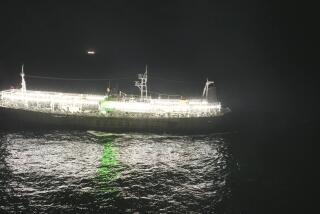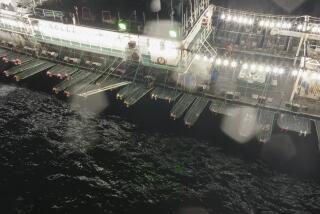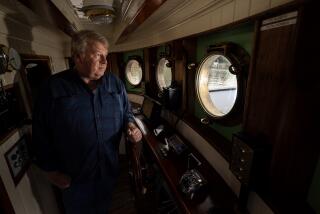Hooked on His Job : Crew of the Traveler Sets Out Nightly in Search of Bait Fish
It was at 5 a.m. when Sandy Vernand finally surrendered to impatience.
For hours, the 71-year-old commercial fisherman hunted for a good-sized school of fish. Experience told him to wait, be patient, don’t take action until there were fish in the water beneath him.
But the night was passing him by, and Vernand reluctantly signaled to his crew to release the net.
Hand over hand, the three men dropped 1,200 feet of netting around a churning school of fish that appeared as a red blob on Vernand’s sonar screen.
The crane on the 54-foot fishing trawler then hoisted the latticework out of the ocean, and the wriggling mass of silvery anchovies rose to the surface.
The tiny fish glittered under the powerful lights used to illuminate the deck. They were half the size the crew normally likes, but Vernand’s 18-year-old grandson scooped them by the net full into waiting tanks of seawater.
In all, they had netted less than a ton of fish, a fraction of the normal catch. It had been a long night--the prime time for bait fishing--and dawn was less than an hour away.
“Some nights we end up with 15 tons in the net, and some nights we get none,” said Vernand, who, after 50 years as a commercial fisherman, is undaunted by one off night.
“The only thing for certain about this job is that there’s never a night when I’m stuck behind a desk, surrounded by four walls and a ceiling.”
After decades working at sea, Vernand said he has no intention of slowing down, even as California’s commercial fishing industry faces increasing hardship from overfishing, increasing government regulation and competition from cheaper imported fish.
His bait business is a family affair.
Every morning at 1 a.m., Vernand, his son Doug, 44, and grandson, Aaron Knudsen, and a hired crewman set out on the Traveler for the deepest underwater canyons off the Ventura County coast.
In sections of those undersea canyons, Vernand and his crew have worked their best nights, hoisting several tons of fish onto the slippery deck and into the bait tanks.
Vernand has been fishing Southern California waters since 1945, when he defied his father and walked directly from the class registration line at USC to the fishing docks at Redondo Beach.
After spending a career running a variety of sport and commercial fishing vessels, Vernand decided to fish exclusively for bait.
It is a lucrative business in spite of the condition of the commercial fishing industry, which has declined sharply in California waters since 1989.
Figures released last month by the California Department of Fish and Game show a steady drop in the amount of fish caught in California’s coastal waters from nearly 500 million pounds in 1989 to 299 million pounds in 1992.
Nevertheless, Vernand said his operation grosses about $300,000 a year, enough to maintain his boat and equipment, pay his three-man crew, and allow him to travel to USC’s away football games every season.
His biggest customers are Ventura County’s sportfishing landings. He provides them a fresh supply of bait in exchange for 15% of the landings’ profits.
He sells the rest of the fish, mostly anchovies and sardines, to packers who freeze them and resell them to a host of markets and restaurants. One customer, Vernand said, is a ritzy New York City pizza parlor that fancies the fresh anchovies.
Out at sea, though, finances are an afterthought.
The 54-foot vessel, with its massive cranes and deep tanks, cut slowly through the waves and into a night. Its path was lighted only by the moon.
The only company on the water last Thursday came from a Santa Barbara bait boat which strayed south because fishing near its port had been so poor.
“When there are so few of us out here, there is a lot of cooperation between the boats,” Vernand said. “But the company is rare. Up until a year and a half ago, we were the only boat on the water.”
As his son and grandson napped in the cabin, Vernand and crewman Scotty Niven monitored several screens of sonar equipment designed to locate fish in the water.
Niven, 26, drove a tow truck before being lured into fishing.
“I worked for a while as a deckhand, but I got tired of catching the fish one at a time,” Niven said. “I wanted to catch tons and tons.”
Despite the odd hours, Niven said he likes the job so much that he hopes someday to skipper his own vessel.
“You have your days free, you don’t have to go to the gym because the work is so tough, and it’s not like sitting at a desk pushing a pencil eight hours a day.”
Instead, Niven spends much of the evening at the helm of the Traveler while Vernand watches the water.
On a truly black night, Vernand said, phosphorescence swirling around the darting fish makes the schools visible from the ocean’s surface.
“We call it fire in the water,” he said. “You can see them even when they’re 40 or 50 feet down. It’s an incredible sight.”
But on this night, Vernand said, there was almost no hope of seeing the fish without the high-tech equipment. The moon had cast too much light.
“When we have a clear night and a bright moon it’s definitely a bad sign,” Niven explained. “The fish are attracted to the light, so when there’s a big light in the sky, they have a tendency to scatter everywhere.”
Vernand uses powerful floodlights to draw the fish into a tight ball. On a bright night the efforts are usually fruitless.
Such was the case at 5 a.m. when Vernand finally called for the crew to drop the nets in the water.
After the meager haul, the Traveler’s two tanks, which at capacity can hold 40 tons of fish, contained only about a ton of anchovies. A typical night’s load is 2 1/2 tons of fish. It was 6 a.m. and they were not even halfway to their mark.
At 6:15 a.m. the wind changed, and the crew detected it immediately.
“You can tell by the smells,” Niven said. “It’s pretty amazing when you’re two miles from shore and you start smelling sage brush.”
But their luck did not change with the wind. Several more hours of circling brought nothing. At daybreak, Vernand maneuvered the Traveler atop another school of fish while his son was lowered into the water in a small skiff.
They used the skiff, equipped with more powerful lights, to draw as many fish as they could to the surface, before setting the net a second time. After an hour of preparation, the whining gears of the crane drew up a net which was nearly empty. It held only a few mackerel and a five-foot thresher shark, which Doug fileted for dinner.
“It’s not an exact science,” Vernand said as the Traveler turned for home. “You can only hope there will be more there tomorrow.”
By this time, Vernand’s son and grandson have joined him on the bridge. Much like his grandfather, Aaron Knudsen said he cannot imagine working in any other field.
“I know this is what I want to be doing,” he said. “I like having my days free and I like working on the water.”
Vernand said he does nothing to discourage his family from fishing.
“I’m quite happy about it,” he said of his grandson’s interest. “I don’t think I’m going to be here forever.”
As they pulled into the Traveler’s slip in the Channel Islands Harbor after a discouraging night of work, skipper and crew had regained their spirit.
“Even when things are rough, there aren’t too many days that guys catch more than they do,” Niven said of the Vernand family. “These guys are some first-class fishermen.”
More to Read
Sign up for Essential California
The most important California stories and recommendations in your inbox every morning.
You may occasionally receive promotional content from the Los Angeles Times.










